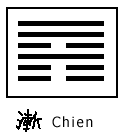
Wind Moves the Mountain
Presented July 5, 2000
For today's text I will refer to Hexagram #53 from the I Ching,
"Chien": Wind over Mountain - Penetration, Infiltration, Development, Gradual Progress.

What is the foundation of Kung Fu?
I've been at both ends of this question. As a student I was taught that the foundation of Kung Fu training was stancework. This was accurate as far as it went, but the problem that I kept running into was what constituted the foundation of stancework. I spent much time studying the problem. I began my research at the root and saw that every level of training was simply an extension of that foundation. But what gave power to the stances? The answer took me to another level of training. The answer I had found was simply "breath". The air that we breathe is the root of Kung Fu training.
If a practitioner is not able to breathe fully and efficiently with natural ease, his or her body will not be able to perform for any length of time or with much power. I have often witnessed a martial artist demonstrate his technical ability only to conclude his demonstration completely winded. What this indicates is that he has used his reserves of power for the demonstration. He has exerted and exhausted himself, but the essence of Kung Fu is effortless action.
All movement begins with wind. To truly penetrate to the depth of our ability it is necessary to master control of the breath.
The word Chi (or Qi, Ki, or Prana) is often translated as oxygen. This translation is incomplete. Yes, it is oxygen absorbed from the atmosphere; but through my training I have come to understand Chi in a more subtle way. It is the potential energy that in the course of breathing we convert to kinetic energy. When this energy conversion keeps a natural cadence or rhythm with our movements, we experience effortless action. All too often we see movements performed while the practitioner holds his breath, which not only shuts down the supply of oxygen but causes him to retain in his lungs carbon dioxide and other noxious residues of spent fuel which he should have exhaled. Then, in an inefficient manner, he gasps for breath. By this failure to breathe properly, he has limited his ability. Stance may be the foundation of Kung Fu, but breath is the foundation of stance.
How do we promote penetration of wind energy into the mountain strength of stance? How do we infuse and infiltrate Chi energy into our entire body?
There are two basic methods of training the breath. The first is called Dantien breathing. To perform this breath technique sit or stand in a relaxed posture. Inhale deeply and slowly while expanding the abdomen. Relax the abdomen to exhale. Do not deliberately expand the chest during this exercise. The goal is to relax and breathe deeply and slowly from the abdomen, in other words, to breathe from the lower Dantien.
The second breathing technique is called the Healing Breath. To perform this exercise sit in a relaxed posture. Inhale slowly and deeply for a count of one. Completely fill the chest. Hold the breath for a count of four and then slowly exhale to the count of two while contracting the abdominal muscles, expelling all the air from the base of the lungs. The prolonged extension and gentle relaxation of the thoracic muscles will cause the muscles to release serotonin, the body's natural chemical relaxant. Feel the relaxation and then commence another breath cycle. Mastery of this technique enables the practitioner to nullify any inhibiting feeling of fear or tension. For more information about this technique, consult The Seventh World of Chan Buddhism, Chapter 10.. which is found on this website under Zen Instruction.
Please feel free to email me with any comments or questions. cjs@hsuyun.org